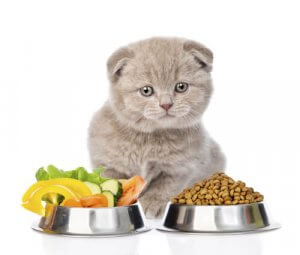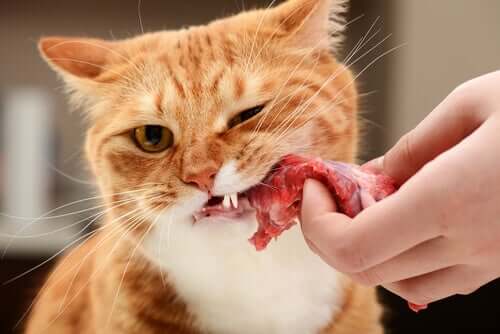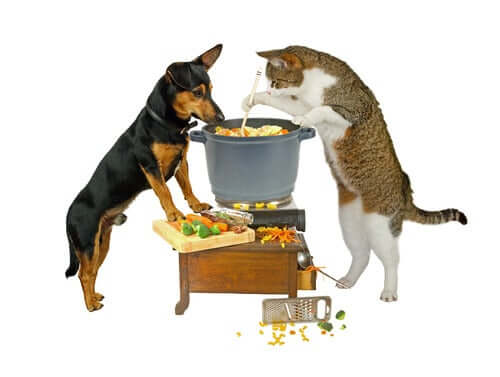People Food You Can Share with Your Cat

Sometimes it’s difficult to resist a cat’s sweet look and you’ve no choice but to share your “people food” with them. However, you must know what kind of edibles you can share and which could be toxic to them.
Within the wide variety of people food out there, it seems we can share some of it with our cats and dogs. Though everyone knows that cats are pickier than dogs when it comes to eating, dogs will eat just about anything.
Pets are highly curious about the smells that come out of your kitchen. So it’s hard to resist their sweet begging look when they’re determined to get a piece of what you’re consuming. So, you must know what type of food you can share with them and which you can’t.
Hungry like a cat

Cats are born carnivores and they have specific nutritional requirements. They need good sources of animal protein and a low intake of carbohydrates. The diet of domestic cats should include two types of food: dry, wet or a mixture of both.
There are no vegan cats. In fact, their digestive systems are adapted specifically for a meat-based diet. Thus, a cat’s digestive tract is short and acidic and processes raw food highly efficiently in less than 12 hours. This leaves very little time for bacteria to proliferate.
Do keep in mind that very young or older cats, as well as those with a compromised immune system or who were recently given antibiotics, are definitely prone to infections. Make sure you get your food from quality, trusted sources.
People food your cat can eat

Cats are highly curious and will be the first to be in the kitchen when you’re cooking or about to eat, especially if it’s fish or meat. In addition, they eat more often than dogs although in smaller proportions. In any case, they’ll gladly give it up if they think they can meow you into sharing some of your delicious people food.
The food request behavior of a cat that is hungry is sort of funny. They’ll meow, and then they’ll rub against your leg. This is a way to get your attention so you’ll start feeding them.
People food is varied and some of it is highly nutritious
Some people food is good for animals. However, do keep in mind that each animal will react differently to it and that it varies depending on the species.
- Meat. Cats are carnivores, and they’ll eat any kind of meat. If your cat doesn’t have opportunities to exercise then feed them lean meat. The best options are raw meat from muscles and organs. Good sources include poultry, rabbit, and fish.
- Vegetables and fruits. Cat’s don’t actually need fruit and vegetables and carbohydrates but you can share some of them if they want to eat them. The best ones for them are spinach, pumpkin, zucchini, carrots, sweet potatoes, apples, bananas, cantaloupe, and watermelon. Note that some food items like avocados, garlic, onion, and raisins could be toxic to them.
- Eggs and dairy. Felines benefit greatly from eating raw eggs. They can also eat cheese in low quantities.
- Grains and legumes. In addition, you can feed your cat different legumes such as beans or lentils, brown rice, and oatmeal. Beans are, in fact, part of the hypoallergenic food group which also includes different types of fruits and vegetables. When combined with meat, these food items will benefit your cat in several ways.
This kind of diet will:
- Improve their digestion
- Greatly reduce their stool odor and volume
- Promote a healthy coat so there’ll be less shedding and fewer hairballs
- Increase their energy
- Help them lose weight if they need to
- Promote their dental and urinary health
People food – conclusion
As you can see, there are many human foods you can share with your cats, although there are also factors specific to every animal that you should take into account. If the cat needs a special diet for whatever reason then you must consult your veterinarian and stick with the diet they recommend.
Thanks for reading.
Sometimes it’s difficult to resist a cat’s sweet look and you’ve no choice but to share your “people food” with them. However, you must know what kind of edibles you can share and which could be toxic to them.
Within the wide variety of people food out there, it seems we can share some of it with our cats and dogs. Though everyone knows that cats are pickier than dogs when it comes to eating, dogs will eat just about anything.
Pets are highly curious about the smells that come out of your kitchen. So it’s hard to resist their sweet begging look when they’re determined to get a piece of what you’re consuming. So, you must know what type of food you can share with them and which you can’t.
Hungry like a cat

Cats are born carnivores and they have specific nutritional requirements. They need good sources of animal protein and a low intake of carbohydrates. The diet of domestic cats should include two types of food: dry, wet or a mixture of both.
There are no vegan cats. In fact, their digestive systems are adapted specifically for a meat-based diet. Thus, a cat’s digestive tract is short and acidic and processes raw food highly efficiently in less than 12 hours. This leaves very little time for bacteria to proliferate.
Do keep in mind that very young or older cats, as well as those with a compromised immune system or who were recently given antibiotics, are definitely prone to infections. Make sure you get your food from quality, trusted sources.
People food your cat can eat

Cats are highly curious and will be the first to be in the kitchen when you’re cooking or about to eat, especially if it’s fish or meat. In addition, they eat more often than dogs although in smaller proportions. In any case, they’ll gladly give it up if they think they can meow you into sharing some of your delicious people food.
The food request behavior of a cat that is hungry is sort of funny. They’ll meow, and then they’ll rub against your leg. This is a way to get your attention so you’ll start feeding them.
People food is varied and some of it is highly nutritious
Some people food is good for animals. However, do keep in mind that each animal will react differently to it and that it varies depending on the species.
- Meat. Cats are carnivores, and they’ll eat any kind of meat. If your cat doesn’t have opportunities to exercise then feed them lean meat. The best options are raw meat from muscles and organs. Good sources include poultry, rabbit, and fish.
- Vegetables and fruits. Cat’s don’t actually need fruit and vegetables and carbohydrates but you can share some of them if they want to eat them. The best ones for them are spinach, pumpkin, zucchini, carrots, sweet potatoes, apples, bananas, cantaloupe, and watermelon. Note that some food items like avocados, garlic, onion, and raisins could be toxic to them.
- Eggs and dairy. Felines benefit greatly from eating raw eggs. They can also eat cheese in low quantities.
- Grains and legumes. In addition, you can feed your cat different legumes such as beans or lentils, brown rice, and oatmeal. Beans are, in fact, part of the hypoallergenic food group which also includes different types of fruits and vegetables. When combined with meat, these food items will benefit your cat in several ways.
This kind of diet will:
- Improve their digestion
- Greatly reduce their stool odor and volume
- Promote a healthy coat so there’ll be less shedding and fewer hairballs
- Increase their energy
- Help them lose weight if they need to
- Promote their dental and urinary health
People food – conclusion
As you can see, there are many human foods you can share with your cats, although there are also factors specific to every animal that you should take into account. If the cat needs a special diet for whatever reason then you must consult your veterinarian and stick with the diet they recommend.
Thanks for reading.
All cited sources were thoroughly reviewed by our team to ensure their quality, reliability, currency, and validity. The bibliography of this article was considered reliable and of academic or scientific accuracy.
-
Sánchez ÁM. ALIMENTACIÓN VEGANA PARA PERROS Y GATOS. :11. [Internet]. Disponible en: http://files.ruth-sanz-sierra.webnode.es/200003665-66e6d7156f/ALIMENTACI%C3%93N%20VEGANA%20PARA%20PERROS%20Y%20GATOS.pdf
-
Horwitz D, Soulard Y, Junien-Castagna A. Comportamiento alimentario del gato. 1:40. [Internet]. Disponible en: https://www.royalcanin.es/wp-content/uploads/2016/05/Cap-13-Comportamiento-alimentario-del-gato.pdf
-
Goy-Thollot I, Elliott DA. Nutrición y cuidados intensivos en el gato. 1:33. [Internet]. Disponible en: https://www.royalcanin.es/wp-content/uploads/2016/05/Cap-12-Nutricion-y-cuidados-intensivos-en-el-gato.pdf
This text is provided for informational purposes only and does not replace consultation with a professional. If in doubt, consult your specialist.








